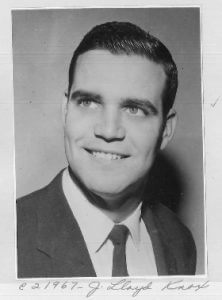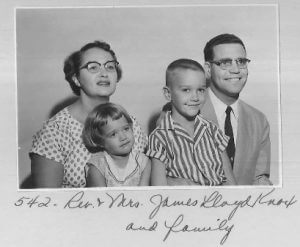
Board of Missions of the Methodist Church , “Mission Photograph Album - Portraits #10 Page 0110,” UMC Digital Galleries, accessed November 27, 2018, http://catalog.gcah.org/omeka
/items/show/61197.
Theological Educator
Lloyd Knox used his skills and leadership in two different societies. He and his family had gone to Cuba, where he taught in the Evangelical Theological Seminary in Matanzas. In September 1960, the U.S. embassy sent word to all U.S. citizens to leave Cuba. But the embassy did not provide assistance for that to happen. Buying a ticket home meant paying in U.S. dollars. But missionaries had no dollars, because their pay went straight to the banks of the countries where they served. Finally the Board of Missions sent U.S. currency to Knox, but by the time the money arrived, the earliest ticket reservation he could make was for more than a year later. Although he thought Castro’s regime might fall during that time, he used connections through an uncle to get a ticket. When it was time for his plane to leave, 250 students and faculty from the school came to see him off. Leaving was emotionally difficult. He had been part of the school and called to the work; he felt like a shepherd leaving his sheep.
His next assignment was at the Instituto Superior Evangelico de Estudios Teologicos (ISEDET) in Buenos Aires. Despite the similarity of language, he found many cultural differences. Argentina was a more closed society, a man’s society. He later described his tenure as paternalistic, “The way missionaries were always looking out for people.” The seminary itself was more European in its approach (academic and philosophical) than evangelistic. This perspective mirrored the culture, which also embodied the values of nineteenth-century rationalism. These traits as well as the presence of the established Roman Catholic Church made development of the Protestant churches difficult. But Vatican II and Liberation Theology actually served to bring the two groups closer together.

Board of Missions of the Methodist Church , “Mission Photograph Album - Portraits #11 Page 0042,” UMC Digital Galleries, accessed November 27, 2018, http://catalog.gcah.org/omeka
/items/show/61280.
Argentina was also a society with many immigrants, especially German, Eastern European, and Russian. Services of worship were in English as well as Spanish, though Knox felt that the board was foolish to continue to support bilingual worship. He did preach in Spanish and noted that when he got stuck for a Spanish word, someone in the congregation would call it out.
Despite the paternalistic nature of the culture and the country, Knox worked with many women who became licensed preachers. Unmarried women in particular were sent to rural areas because church leaders with children tried to stay near the better schools. Like most missionaries, Knox found many ways to be in ministry. In addition to his teaching, he wrote and distributed a magazine to support the mission efforts.
Taken from Linda Gesling, Mirror and Beacon: The History of Mission of The Methodist Church, 1939-1968. (New York: General Board of Global Ministries, The United Methodist Church, 2005), p. 273.




